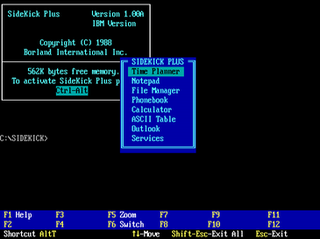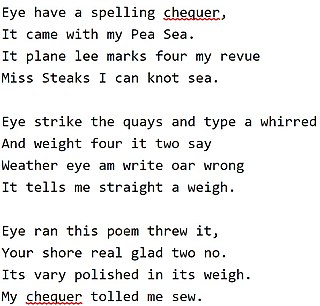Related Research Articles

Microsoft Word is a word processor program developed by Microsoft. It was first released on October 25, 1983, under the name Multi-Tool Word for Xenix systems. Subsequent versions were later written for several other platforms including: IBM PCs running DOS (1983), Apple Macintosh running the Classic Mac OS (1985), AT&T UNIX PC (1985), Atari ST (1988), OS/2 (1989), Microsoft Windows (1989), SCO Unix (1990), macOS (2001), Web browsers (2010), iOS (2014) and Android (2015).

WordPerfect (WP) is a word processing application, now owned by Alludo, with a long history on multiple personal computer platforms. At the height of its popularity in the 1980s and early 1990s, it was the market leader of word processors, displacing the prior market leader WordStar.
Desktop publishing (DTP) is the creation of documents using dedicated software on a personal ("desktop") computer. It was first used almost exclusively for print publications, but now it also assists in the creation of various forms of online content. Desktop publishing software can generate page layouts and produce text and image content comparable to the simpler forms of traditional typography and printing. This technology allows individuals, businesses, and other organizations to self-publish a wide variety of content, from menus to magazines to books, without the expense of commercial printing.

MacPaint is a raster graphics editor developed by Apple Computer and released with the original Macintosh personal computer on January 24, 1984. It was sold separately for US$195 with its word processing counterpart, MacWrite. MacPaint was notable because it could generate graphics that could be used by other applications. It taught consumers what a graphics-based system could do by using the mouse, the clipboard, and QuickDraw picture language. Pictures could be cut from MacPaint and pasted into MacWrite documents.
MacWrite is a discontinued WYSIWYG word processor released along with the first Apple Macintosh systems in 1984. Together with MacPaint, it was one of the two original "killer applications" that propelled the adoption and popularity of the GUI in general, and the Mac in particular.

AppleWorks was an integrated office suite containing a word processor, database, and spreadsheet. It was developed by Rupert Lissner for Apple Computer, originally for the Apple II and launched in 1984. Many enhancements for AppleWorks were created, the most popular being the TimeOut series from Beagle Bros which extended the life of the Apple II version of AppleWorks. Appleworks was later reworked for the Macintosh platform.
Claris International Inc., formerly FileMaker Inc., is a computer software development company formed as a subsidiary company of Apple Computer in 1987. It was given the source code and copyrights to several programs that were owned by Apple, notably MacWrite and MacPaint, in order to separate Apple's application software activities from its hardware and operating systems activities.
Taste is a Macintosh word processor that combined a number of basic features from page layout software—just a "taste" of it—to build a unique solution to preparing documents. Taste was originally offered by DeltaPoint, the publishers of the famed MindWrite, but was eventually spun off to a third party before finally disappearing. Taste works with Mac OS 9, but not macOS, and has not been available for purchase for several years. In many ways Apple's recent Pages application shares the basic "idea" of Taste, combining word processing with page layout.

Borland Sidekick was a personal information manager (PIM) launched by American software company Borland in 1984 under Philippe Kahn's leadership. It was an early and popular terminate-and-stay-resident program (TSR) for MS-DOS which enabled computer users to activate the program using a hot key combination while working in other programs. Although a text-mode program, Sidekick's window-based interface echoed that of the Apple Macintosh and anticipated the eventual look of Microsoft Windows 2.0. It included a personal calendar, text editor, calculator, ASCII chart, address book, and phone dialer. According to the prospectus for Borland's initial public offering of stock to the public, Sidekick sold more than 1 million copies in its first three years.

PC-Write was a computer word processor and was one of the first three widely popular software products sold via the marketing method that became known as shareware. It was originally written by Bob Wallace in early 1983.

In software, a spell checker is a software feature that checks for misspellings in a text. Spell-checking features are often embedded in software or services, such as a word processor, email client, electronic dictionary, or search engine.

WriteNow is a word processor application for the original Apple Macintosh and later computers in the NeXT product line. The application is one of two word processors that were first developed with the goal that they be available at the time of the Mac product launch in 1984, and was the primary word processor for computers manufactured by NeXT. WriteNow was purchased from T/Maker by WordStar in 1993, but shortly after that, WordStar merged with SoftKey, which ultimately led to its discontinuation. It had a combination of powerful features, excellent performance, and small system requirements.
FullWrite Professional was a word processor application for the Apple Macintosh, released in late 1988 by Ashton-Tate. The program was notable for its combination of a true WYSIWYG interface, powerful long-document processing features, and a well regarded outliner. It was also noted for its high resource demands, bugs, and its very late release.

Microsoft Write is a basic word processor included with Windows 1.0 and later, until Windows NT 3.51. Throughout its lifespan it was minimally updated, and is comparable to early versions of MacWrite. Early versions of Write only work with Write Document (.wri) files, which are a subset of the Rich Text Format (RTF). After Windows 3.0, Write became capable of reading and composing early Word Document (.doc) files. With Windows 3.1, Write became OLE capable. In Windows 95, Write was replaced with WordPad; attempting to open Write from the Windows folder will open WordPad instead.

SuperPaint is a graphics program capable of both bitmap painting and vector drawing. SuperPaint was one of the first programs of its kind, combining the features of MacPaint and MacDraw while adding many new features of its own.

1st Word is a word processor program for the Atari ST developed by GST Computer Systems and published in 1985. It was given away with all ST systems from December 1985 for the next two years. Although it was relatively well received, it was a very simple program, lacking most power features and was very slow when working in large documents. In spite of any limitations, its wide availability made the program's .DOC file format became a de facto standard for the platform and was widely supported by other programs like desktop publishing systems.

The first version of Microsoft Word was developed by Charles Simonyi and Richard Brodie, former Xerox programmers hired by Bill Gates and Paul Allen in 1981. Both programmers worked on Xerox Bravo, the first WYSIWYG word processor. The first Word version, Word 1.0, was released in October 1983 for Xenix and MS-DOS; it was followed by four very similar versions that were not very successful. The first Windows version was released in 1989, with a slightly improved interface. When Windows 3.0 was released in 1990, Word became a huge commercial success. Word for Windows 1.0 was followed by Word 2.0 in 1991 and Word 6.0 in 1993. Then it was renamed to Word 95 and Word 97, Word 2000 and Word for Office XP. With the release of Word 2003, the numbering was again year-based. Since then, Windows versions include Word 2007, Word 2010, Word 2013, Word 2016, and most recently, Word for Office 365.
Spell Catcher, originally known as Thunder!, is a stand-alone spell checker for Atari ST, Macintosh and Microsoft Windows systems. It was published continually from 1985 until the untimely 2012 death of the primary developer, Evan Gross. Its original name refers to its lightning-fast speed, which set it apart from other spell checkers on the platform like Spellswell.
Reference Software International, Inc. (RSI), was an American software developer active from 1985 to 1993 and based in Albuquerque, New Mexico, and San Francisco, California. The company released several productivity and reference software packages during their lifespan, including the highly popular Grammatik grammar checker, for IBM PCs and compatibles running DOS. The company was acquired by WordPerfect Corporation in 1993.
Trapeze is a discontinued spreadsheet program for Macintosh systems running classic Mac OS. It introduced the concept of using named ranges for most operations instead of cell addresses, allowing formulas to be freed of the location of the data on the page. This, in turn, made updating the sheets by moving data around a safe operation, whereas in contemporary programs like Microsoft Excel and Lotus 1-2-3 this often led to broken formulas. The system did not rely on the sheet as the basis for storage, and allowed multiple tables, charts, graphics and text, which they referred to as "blocks", to be positioned freely.
References
Citations
- 1 2 Silveira 1988, p. 161.
- 1 2 Bortman 1987, p. 90.
- ↑ Flyer 1986.
- 1 2 3 4 5 Seelig 1987, p. 46.
- ↑ Bulletin 1987.
- ↑ Acquire 1988, p. 33.
- ↑ "Delta Point Gives Users a Low-Cost Taste". InfoWorld. January 14, 1991. p. 28. Retrieved 9 October 2021.
- 1 2 Seelig 1987, p. 47.
- 1 2 Stone 1990, p. 27.
- ↑ Miller 1987, p. 49.
- ↑ Rubin 1987a, p. 52.
- ↑ Rubin 1987a, p. 54.
- ↑ Bortman 1987, p. 95.
- ↑ Seelig 1987, p. 61.
- ↑ McNeill 1987, p. 60.
- ↑ Assadi 1988, p. 32.
- ↑ Silveira 1988, p. 172.
- ↑ Silveira 1988, p. 174.
- ↑ Lach 1987, p. 9.
Bibliography
- McNeill, Dan (December 1987). "Macintosh: The Word Explosion". Compute!'s Apple Applications. pp. 54–60. Retrieved 14 September 2016.
- Miller, Michael (2 February 1987). "MindWrite on Right Track to Smoothly Integrate Word Processing, Outlining". InfoWorld. p. 49.
- Rubin, Charles (9 February 1987). "Program Smoothly Integrates Outlining, Word Processing". InfoWorld. pp. 52–54.
- Assadi, Barbara (8 August 1988). "MindWrite, Version 1.1". InfoWorld. p. 32.
- Rubin, Charles (28 September 1987). "Macintosh Word Processors". InfoWorld. pp. S9–S23.
- Lach, Eric (22 June 1987). "Users Staying with Word and Mac Write". InfoWorld. pp. 8–9.
- Silveira, Ted (February 1988). "Out of Your Mind". MacUser. pp. 160–174.
- "Publisher, Mail-Order House Split Up". MacWorld. June 1987. p. 13.
- Bortman, Henry (August 1987). "In Your Mind Write". MacUser. pp. 90, 92–95.
- "Access Buys Mindwrite, Plans to Acquire Trapeze". InfoWorld. 11 January 1988. p. 33.
- Stone, Paula (4 July 1990). "Access Offers Updates For Mindwrite, Trapeze". InfoWorld. p. 27.
- Seelig, Fred (April 1987). "MINDWRITE: A Review" (PDF). Washington Apple Pi. pp. 46–47, 61.